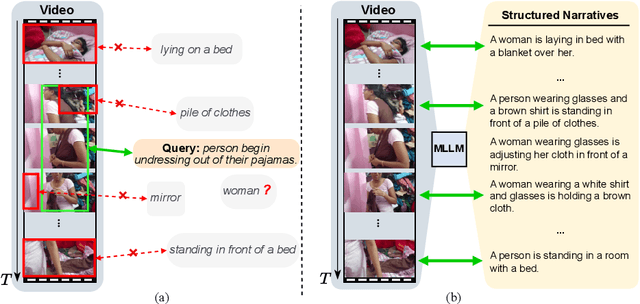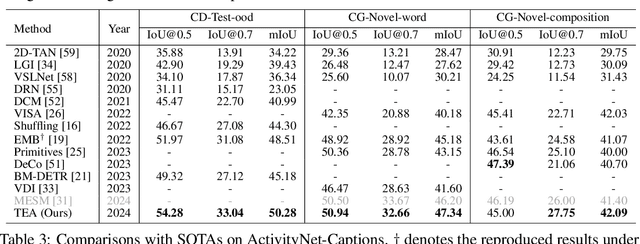Weitong Cai
MLLM as Video Narrator: Mitigating Modality Imbalance in Video Moment Retrieval
Jun 25, 2024



Abstract:Video Moment Retrieval (VMR) aims to localize a specific temporal segment within an untrimmed long video given a natural language query. Existing methods often suffer from inadequate training annotations, i.e., the sentence typically matches with a fraction of the prominent video content in the foreground with limited wording diversity. This intrinsic modality imbalance leaves a considerable portion of visual information remaining unaligned with text. It confines the cross-modal alignment knowledge within the scope of a limited text corpus, thereby leading to sub-optimal visual-textual modeling and poor generalizability. By leveraging the visual-textual understanding capability of multi-modal large language models (MLLM), in this work, we take an MLLM as a video narrator to generate plausible textual descriptions of the video, thereby mitigating the modality imbalance and boosting the temporal localization. To effectively maintain temporal sensibility for localization, we design to get text narratives for each certain video timestamp and construct a structured text paragraph with time information, which is temporally aligned with the visual content. Then we perform cross-modal feature merging between the temporal-aware narratives and corresponding video temporal features to produce semantic-enhanced video representation sequences for query localization. Subsequently, we introduce a uni-modal narrative-query matching mechanism, which encourages the model to extract complementary information from contextual cohesive descriptions for improved retrieval. Extensive experiments on two benchmarks show the effectiveness and generalizability of our proposed method.
Hybrid-Learning Video Moment Retrieval across Multi-Domain Labels
Jun 03, 2024Abstract:Video moment retrieval (VMR) is to search for a visual temporal moment in an untrimmed raw video by a given text query description (sentence). Existing studies either start from collecting exhaustive frame-wise annotations on the temporal boundary of target moments (fully-supervised), or learn with only the video-level video-text pairing labels (weakly-supervised). The former is poor in generalisation to unknown concepts and/or novel scenes due to restricted dataset scale and diversity under expensive annotation costs; the latter is subject to visual-textual mis-correlations from incomplete labels. In this work, we introduce a new approach called hybrid-learning video moment retrieval to solve the problem by knowledge transfer through adapting the video-text matching relationships learned from a fully-supervised source domain to a weakly-labelled target domain when they do not share a common label space. Our aim is to explore shared universal knowledge between the two domains in order to improve model learning in the weakly-labelled target domain. Specifically, we introduce a multiplE branch Video-text Alignment model (EVA) that performs cross-modal (visual-textual) matching information sharing and multi-modal feature alignment to optimise domain-invariant visual and textual features as well as per-task discriminative joint video-text representations. Experiments show EVA's effectiveness in exploring temporal segment annotations in a source domain to help learn video moment retrieval without temporal labels in a target domain.
Relax Image-Specific Prompt Requirement in SAM: A Single Generic Prompt for Segmenting Camouflaged Objects
Dec 18, 2023Abstract:Camouflaged object detection (COD) approaches heavily rely on pixel-level annotated datasets. Weakly-supervised COD (WSCOD) approaches use sparse annotations like scribbles or points to reduce annotation effort, but this can lead to decreased accuracy. The Segment Anything Model (SAM) shows remarkable segmentation ability with sparse prompts like points. However, manual prompt is not always feasible, as it may not be accessible in real-world application. Additionally, it only provides localization information instead of semantic one, which can intrinsically cause ambiguity in interpreting the targets. In this work, we aim to eliminate the need for manual prompt. The key idea is to employ Cross-modal Chains of Thought Prompting (CCTP) to reason visual prompts using the semantic information given by a generic text prompt. To that end, we introduce a test-time adaptation per-instance mechanism called Generalizable SAM (GenSAM) to automatically enerate and optimize visual prompts the generic task prompt for WSCOD. In particular, CCTP maps a single generic text prompt onto image-specific consensus foreground and background heatmaps using vision-language models, acquiring reliable visual prompts. Moreover, to test-time adapt the visual prompts, we further propose Progressive Mask Generation (PMG) to iteratively reweight the input image, guiding the model to focus on the targets in a coarse-to-fine manner. Crucially, all network parameters are fixed, avoiding the need for additional training. Experiments demonstrate the superiority of GenSAM. Experiments on three benchmarks demonstrate that GenSAM outperforms point supervision approaches and achieves comparable results to scribble supervision ones, solely relying on general task descriptions as prompts. our codes is in: https://lwpyh.github.io/GenSAM/.
 Add to Chrome
Add to Chrome Add to Firefox
Add to Firefox Add to Edge
Add to Edge